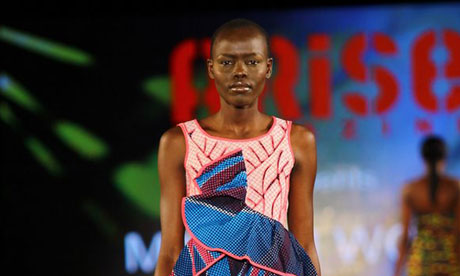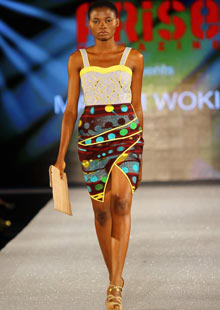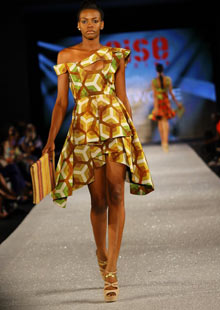
Designer Maryann Kai Kai says Madam Wokie is creating modern clothes while also creating jobs and changing lives in Sierra Leone. Photograph: Picasa
Its inspirations include Sierra Leone's immaculate beaches, Japanese kimonos and Jane Austen quotes, but the most memorable thing about the west African fashion label Madam Wokie is its name.
Madam Wokie, created by Sierra Leonean designer Maryann Kai Kai, is named after Kai Kai's great-grand aunt, once a paramount chief in the country. A faded black-and-white photo shows an elderly Wokie standing before Queen Elizabeth during a visit to Sierra Leone by the British monarch in 1961. Wokie, regal despite her obvious old age, wears a dramatic and elaborate crown given to her by the Queen.
"Queen Elizabeth gave her a crown!" said Kai Kai. "I wanted to have the whole family history incorporated into the brand name. We come from a long line of strong, forward-thinking women who know how to support each other in life and in enterprise to create success."
The Madam Wokie label is one of a number from countries less prominent on the fashion world's radar to be exhibited at the UN Fashion 4 Development first ladies' luncheon in New York on 26 September. Ban Soon-taek, wife of the UN secretary general Ban Ki-moon, who has called for conditions in clothing factories to be improved, will speak at the lunch, which also hosts Italian Vogue editor, Franca Sozzani, who has promoted African fashion and models.
 Madam Wokie's collections include beautifully cut pencil dresses. Photograph: Picasa
Madam Wokie's collections include beautifully cut pencil dresses. Photograph: Picasa Madam Wokie designs are also inspired by Kai Kai's grandmother who, as the wife of an ambassador, travelled the world.
"My grandmother has all these pictures from her travels and back in the day I used to imagine myself being like her and come up with all these creative sketches," said Kai Kai. The result is Madam Wokie's renowned collections, featuring beautifully cut pencil dresses with generous, edged slits that complement their bold African cloth, flared skirts in burnt orange and green prints, and 1950s silhouettes.
One Nigerian publication called its show at the Arise fashion week in Lagos last year "zesty, summery and fun" with cuts that "accentuated the models' figures to a T".
"My signature look is very structured pieces for women who may work nine to five but also like it very edgy," said Kai Kai. "But one of the things that distinguishes Madam Wokie from other designers is that we are creating modern clothes, but at the same time we are creating jobs and changing lives in Sierra Leone."
Madam Wokie employs youths and women whose husbands were maimed in Sierra Leone's civil war to tie-dye and weave bags and kontri cloth – a distinctive fabric made in Sierra Leone.
Evie Evangelou, founder and president of Fashion 4 Development, said it was a serious misconception that couture is only created in fashion capitals such as Milan, Paris and New York. "We know talented, creative designers in Malaysia, Bangladesh, Kuwait and countless developing cities who are working with materials and techniques that are local to them and, as a result, creating fabulously unique pieces [that] could be found on any fashion week runway."
 Madam Wokie designs have been hailed as 'zesty, summery and fun'. Photograph: Picasa
Madam Wokie designs have been hailed as 'zesty, summery and fun'. Photograph: Picasa The UN event taps into growing interest in African fashion with young designers emboldened by the use of African prints by some of the industry's biggest names.
But many designers in Africa say they are weary of the trend that allows big brands to cash in on African fashion but does little to enable African designers to access global markets.
"African fashion has been around for centuries and suddenly we are seeing a lot of high-end designers like Burberry using African prints – it has generated interest in African fashion," said Kai Kai.
"But as African designers we have to fund our work from our own pockets and even though whenever I travel to New York people say they want to wear my clothes, without outside investment I can't take advantage of that."
via fashion - Google News http://news.google.com/news/url?sa=t&fd=R&usg=AFQjCNHomc49yXcjhF5C1putEaVz5wUGvQ&url=http://www.theguardian.com/fashion/2013/sep/25/designers-un-world-fashion




1 意見:
Madam Wokie combines style, culture, and empowerment. Drawing from Sierra Leonean heritage and named after a pioneering female ancestor, the brand highlights African creativity at international events like the UN Fashion 4 Development luncheon. As fashion meets global business and legal frameworks, students in these areas can gain insights from expert Taxation Law Assignment Help to grasp the financial and legal aspects of creative ventures.
張貼留言